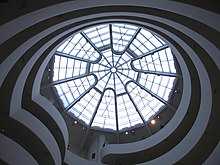Organic Abstraction is an artistic style characterized by "the use of rounded or wavy abstract forms based on what one finds in nature."[1] It takes its cues from rhythmic forms found in nature, both small scale, as in the structures of small-growth leaves and stems, and grand, as in the shapes of the universe that are revealed by astronomy and physics.[2] Nautillus shells and honeycombs are examples of organic structures that have served as inspiration for this work,[3] along with the bones and musculature of the body, both human and animal.[4]

Although organic abstraction has been described as a "feature" rather than "an actual movement,"[1] the style arose in part as a reaction against the austerity of mid-century Constructivist art and is best known for its practitioners of the mid 20th century, whether in sculpture--Jean Arp, Constantin Brâncuși, Henry Moore; architecture--Eero Saarinen, Frank Lloyd Wright (for the Guggenheim Museum); or design--Charles Eames, Isamu Noguchi. Some recent critics contend that the term Biomorphic Abstraction is coming to be used more generally to describe contemporary art produced in this mode.[6]
- ^ a b Delahoyde, Michael. "20th-Century Arts & Humanities". Washington State University. Retrieved 2022-01-09.
- ^ Curtis, Cathy. “Lessons From Nature's Rhythms `Organic Abstractions' Exhibit Is Dedicated to Helping Unravel Art's Mysterie.” Los Angeles Times. August 27, 1989.
- ^ Art, Whitney Museum of American; Phillips, Lisa (1988). Vital Signs: Organic Abstraction from the Permanent Collection. Whitney Museum of American Art. ISBN 978-0-87427-059-4.
- ^ Curtis, Cathy (1989-08-27). "Lessons From Nature's Rhythms : 'Organic Abstractions' Exhibit Is Dedicated to Helping Unravel Art's Mysteries". Los Angeles Times. Retrieved 2022-01-09.
- ^ Co, Francesco Dal (2017-01-01). The Guggenheim: Frank Lloyd Wright's Iconoclastic Masterpiece. Yale University Press. ISBN 978-0-300-22605-8.
- ^ "IdeelArt | The online gallerist". IdeelArt.com. Retrieved 2022-01-09.